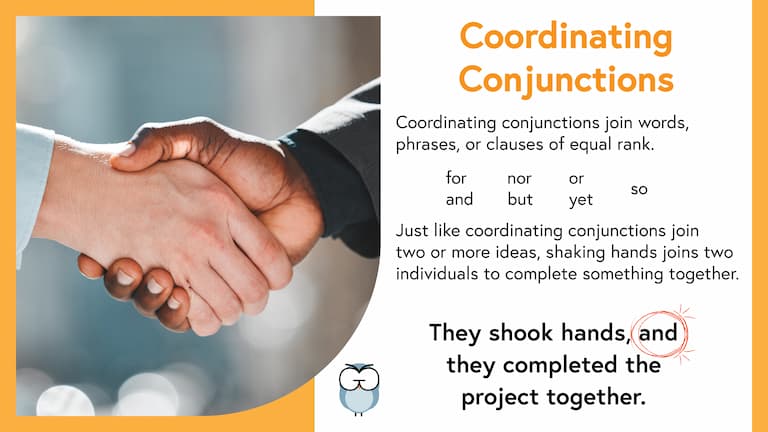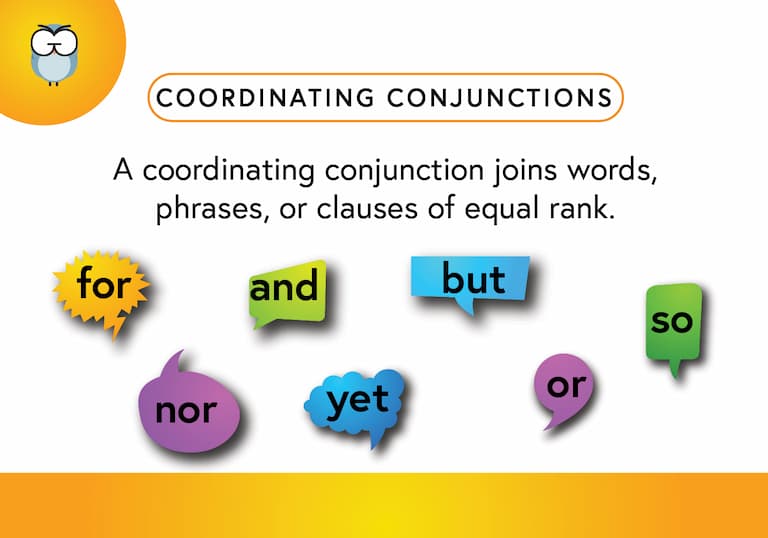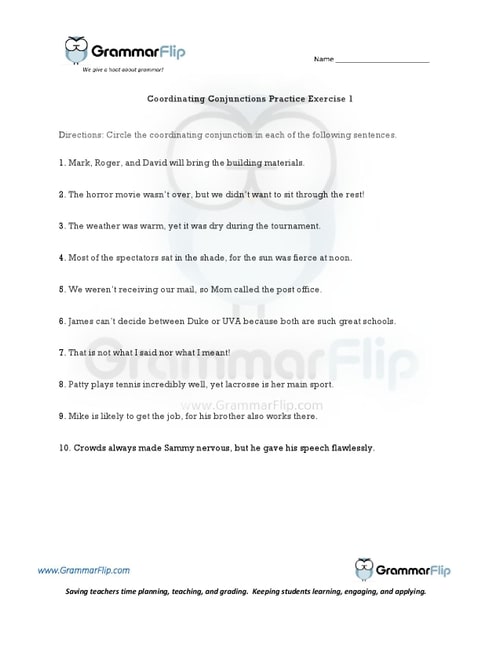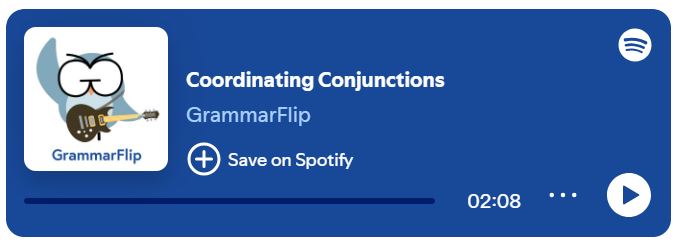Definition of Coordinating Conjunctions
A coordinating conjunction is a grammatical part of speech in the English language that joins words, phrases, or clauses of equal rank.
Some examples of coordinating conjunctions:
For: He was very tired, for he hadn’t slept in days.
And: Shameka and Austin ran at the track meet.
Nor: Neither Vilma nor her sister were interested.
But: I’d like to meet with you over some coffee, but I have another appointment.
Or: Shelly, Justine, or Gustav will meet you at the front gate.
Yet: She wanted to go to the party, yet she knew it was important to study.
So: Jasmine prepared for her test in advance, so she met her friends that evening.
Long-Form Videos: Coordinating Conjunctions
Long-form instructional video lessons allow students to engage with grammar concepts in more depth and detail.
This format provides students with a stronger foundation and a more comprehensive understanding of coordinating conjunctions.
Grammar-in-Context Videos: Coordinating Conjunctions
GrammarFlip’s grammar-in-context videos provide an additional layer of instruction, learning, and relatability.
Our unique and memorable video footage helps solidify the understanding of challenging grammar concepts.
Watch this video to better understand the concept of coordinating conjunctions!
Short-Form Videos: Coordinating Conjunctions
Short-form videos are an excellent way to review grammar concepts. Our two-minute instructional videos help students review the concept of coordinating conjunctions to further solidify their understanding.
Memorable Images: Coordinating Conjunctions
The use of images to connect visual cues with concepts makes it simpler for students to grasp and remember key ideas. GrammarFlip’s memorable images create visual associations that make coordinating conjunctions more engaging and easier to retain.

Definition Cards: Coordinating Conjunctions

Definition cards reinforce grammar concepts by providing clear and concise explanations that students can easily reference for quick review and better retention. GrammarFlip’s definintion cards help students review the concept of coordinating conjunctions to further solidify their understanding.
Music: Coordinating Conjunctions
Learn grammar concepts through music! The unique verses and catchy chorus in our “Coordinating Conjunctions Song” will help your students further understand coordinating conjunctions. Listen for yourself and see if you don’t walk away singing this song to yourself!
Listen to GrammarFlip Music via Spotify, Apple, or Amazon!
Music Videos: Coordinating Conjunctions
Music videos make grammar concepts more engaging and memorable by combining rhythm, visuals, and repetition to reinforce learning. GrammarFlip’s music videos help students retain the concept of coordinating conjunctions more effectively while making the learning process fun and interactive.
Why You Should Use Coordinating Conjunctions in Your Writing
On a general level, coordinating conjunctions play an important role in your writing because they help you to create clear sentences that are concise, and they do that by tying together common elements that have equal importance.
Those common elements from a grammatical standpoint can be words, phrases, or clauses, and you can connect them with the following coordinating conjunctions: for, and, nor, but, or, yet, so.
Some examples:
“I want cake, but I also love ice cream.” Here, “but” connects two contrasting ideas (clauses).
“She enjoys swimming and hiking.” In this case, “and” joins two similar activities (words).
Using coordinating conjunctions in your writing enhances its readability and conveys your ideas in a clearer fashion. Keep mind that coordinating conjunctions are different from subordinating conjunctions. They are both types of conjunctions, but they function differently.
Download a Free Worksheet on Coordinating Conjunctions!
Click the image below to download your free worksheet on coordinating conjunctions!

Do your students know the difference between coordinating conjunctions and subordinating conjunctions?
Explore More GrammarFlip Lessons!
Parts of Speech lessons provide the building blocks of grammar. GrammarFlip covers these topics in detail to ensure a solid foundation is built. First time learners and students seeking to review the parts of speech can both benefit from the instructional videos and slide show reviews.
Parts of the Sentence lessons are critical for understanding how the parts of speech function in language construction. From the basic to the advanced, these lessons will cover a wide range of grammar topics that can be used in any grade level or classroom.
Mechanics and Usage lessons equip students with the necessary skills to communicate clearly to all audiences. With a focus on the application of these concepts in student writing, these lessons tie together both simple constructions of grammar as well as the more complex such that any age or skill level of student will benefit.



